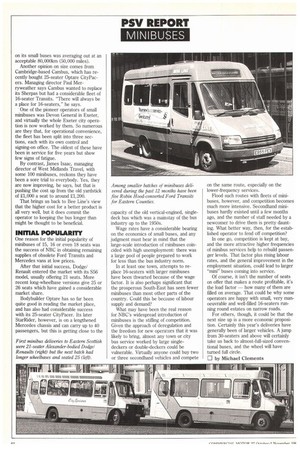PSV REPORT
Page 52

If you've noticed an error in this article please click here to report it so we can fix it.
on its small buses was averaging out at an acceptable 80,000km (50,000 miles).
Another opinion on size comes from Cambridge-based Cambus, which has recently bought 25-seater Optare CityPacers. Managing director Paul Merryweather says Carnbus wanted to replace its Sherpas but had a considerable fleet of 16-seater Transits. "There will always be a place for 16-seaters," he says.
• One of the pioneer operators of small minibuses was Devon General in Exeter, and virtually the whole Exeter city operation is now worked by them. So numerous are they that, for operational convenience, the fleet has been split into three sections, each with its own control and signing-on office. The oldest of these have been in service for five years but show few signs of fatigue.
By contrast, James Isaac, managing director of West Midlands Travel, with some 100 minibuses, reckons they have been a sore trial to everybody. Yes, they are now improving, he says, but that is pushing the cost up from the old yardstick of 21,000 a seat to around £1,200.
That brings us back to Bee Line's view that the higher cost for a better product is all very well, but it does commit the operator to keeping the bus longer than might be thought to be beneficial.
INITIAL POPULARITY
One reason for the initial popularity of minibuses of 15, 16 or even 18 seats was the success of NBC in obtaining remaining supplies of obsolete Ford Transits and Mercedes vans at low prices.
After that initial success, Dodge/ Renault entered the market with its 556 model, usually offering 21 seats. More recent long-wheelbase versions give 25 or 26 seats which have gained a considerable market share.
Bodybuilder Optare has so far been quite good in reading the market place, and has also had considerable success with its 25-seater CityPacer. Its later StarRider, however, is on a lengthened Mercedes chassis and can carry up to 40 passengers, but this is getting close to the First minibus deliveries to Eastern Scottish were 21-seater Alexander-bodied Dodge! Renaults (right) but the next batch had longer wheelbases and seated 25 (left). capacity of the old vertical-engined, singledeck bus which was a mainstay of the bus industry up to the 1950s.
Wage rates have a considerable bearing on the economics of small buses, and any judgment must bear in mind that the large-scale introduction of minibuses coincided with high unemployment: there was a large pool of people prepared to work for less than the bus industry norm.
In at least one town, attempts to replace 16-seaters with larger minibuses have been thwarted because of the wage factor. It is also perhaps significant that the prosperous South-East has seen fewer minibuses than most other parts of the country. Could this be because of labour supply and demand?
What may have been the real reason for NBC's widespread introduction of minibuses is the stifling of competition. Given the approach of deregulation and the freedom for new operators that it was likely to bring, almost any town or city bus service worked by large singledeckers or double-deckers could be vulnerable. Virtually anyone could buy two or three secondhand vehicles and compete on the same route, especially on the lower-frequency services.
Flood such routes with fleets of minibuses, however, and competition becomes much more intensive. Secondhand minibuses hardly existed until a few months ago, and the number of staff needed by a newcomer to drive them is pretty daunting. What better way, then, for the established operator to fend off competition?
In one go, competition is kept at bay, and the more attractive higher frequencies of minibus services help to rebuild passenger levels. That factor plus rising labour rates, and the general improvement in the employment situation, could lead to larger "mini" buses coming into service.
Of course, it isn't the number of seats on offer that makes a route profitable, it's the load factor — how many of them are filled on average. That could be why some operators are happy with small, very manoeuvrable and well-filled 16-seaters running round estates on narrow roads.
For others, though, it could be that the next size up is a more economic proposition. Certainly this year's deliveries have generally been of larger vehicles. A jump from 30-seaters and above will certainly take us back to almost-full-sized conventional buses, and the wheel will have turned full circle.
by Michael Clements














































































